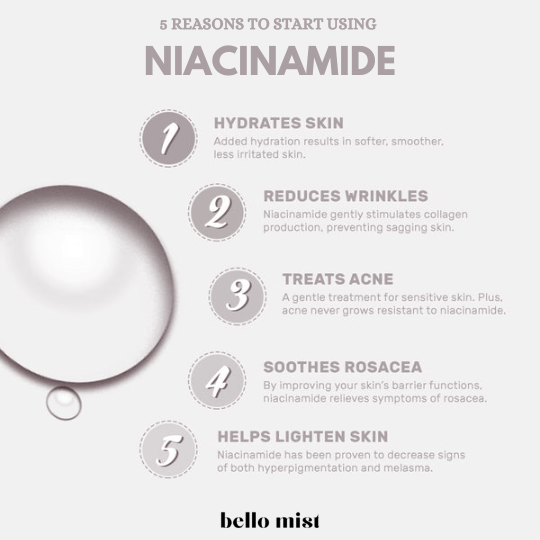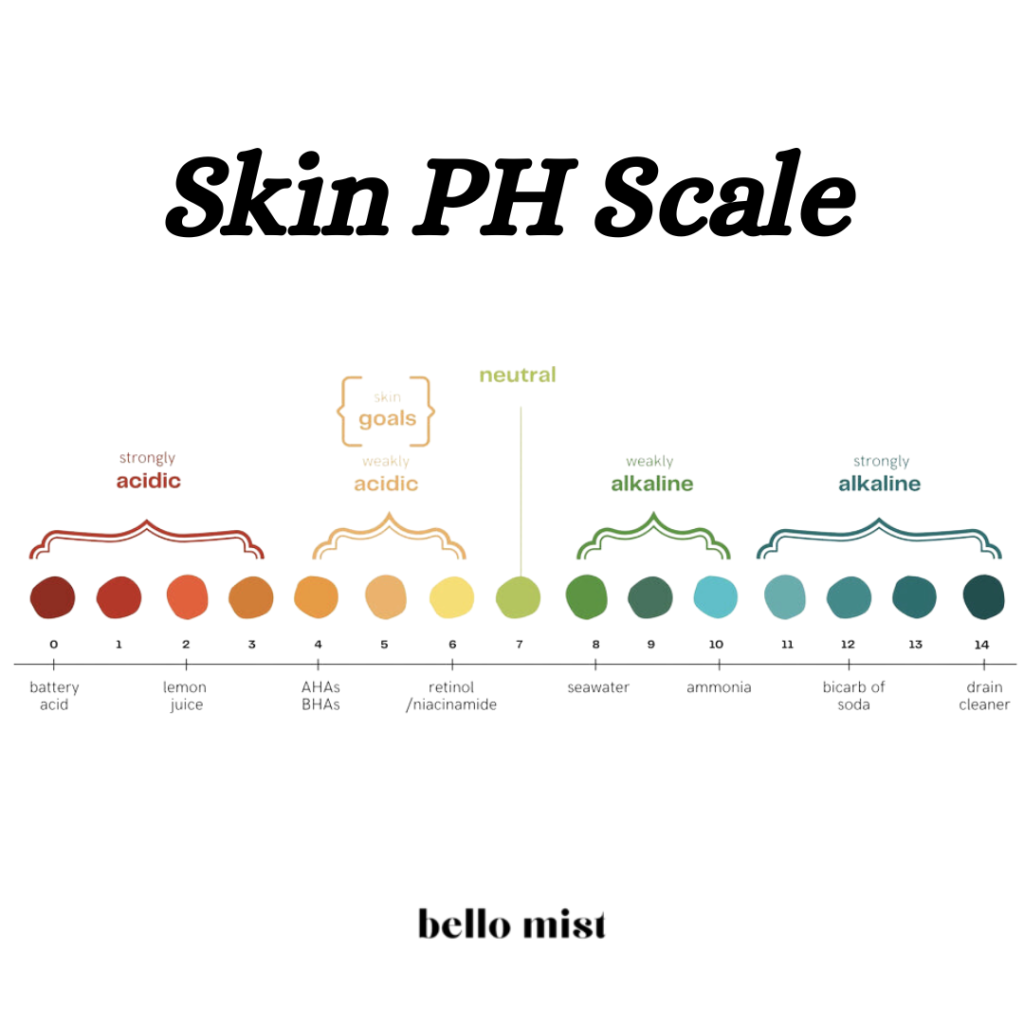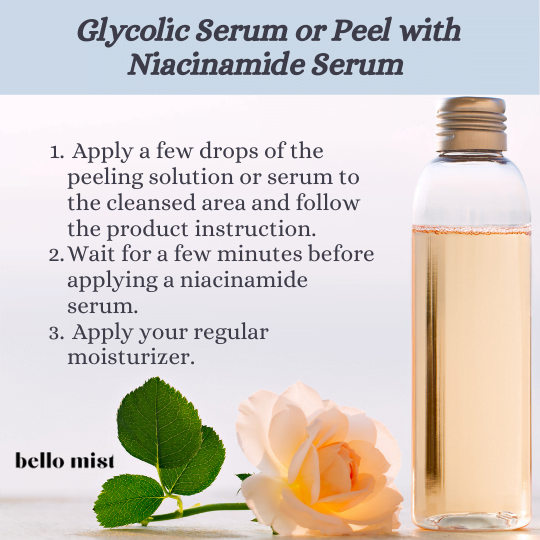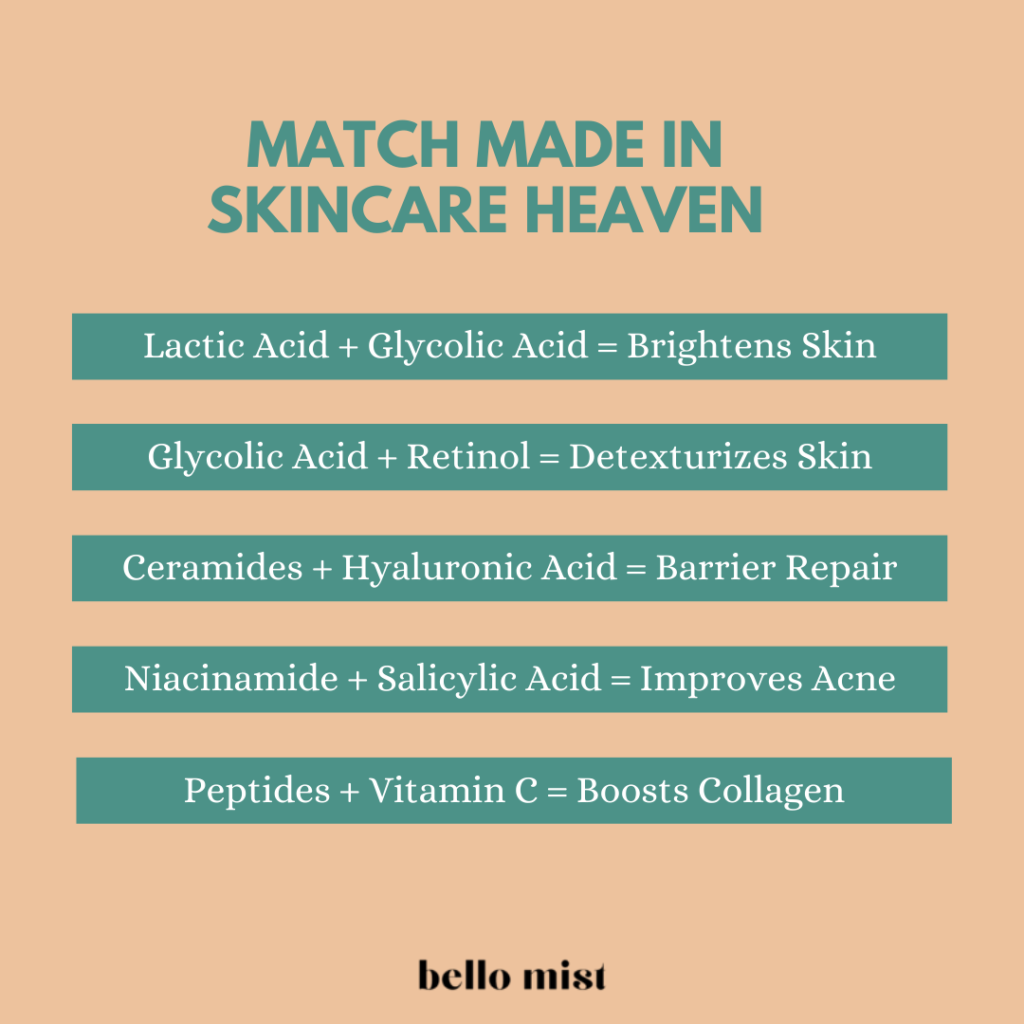If you’re looking for skin-care products that will make your complexion look brighter and smoother, glycolic acid and niacinamide are two of the top choices. But can you use them in the same routine?
It can be confusing to decide whether to mix glycolic acid and niacinamide, look for a product that contains both, or layer them one after the other. Plus, will one of them cancel out the other?
We’ve got all the answers. Read on to learn what glycolic acid and niacinamide can do for your complexion, why they work better when used together, and how to use both in one routine.
What does glycolic acid do for the skin?
Glycolic acid is a kind of AHA and one of the most widespread chemical exfoliants. Exfoliators clear away dead skin cells, producing a more youthful, healthy-looking complexion.
As the AHA with the tiniest particles, it can travel deep into the skin and create a desirable radiance. Here are some of the critical effects it can have:
Exfoliates dead skin cells
Glycolic acid is an excellent choice to exfoliate dead skin cells and unblock pores. It’s a natural product obtained from sugarcane and a much more effective way of removing those cells than traditional exfoliants.
It is also beneficial in treating acne and maintaining healthy skin, but it’s essential to take note of the recommended pH range to ensure your skin stays healthy.
Prevents water loss
Glycolic acid, or AHA, is an effective way to maintain hydration levels in the skin, yielding up to a 30% increase in skin elasticity. This acid breaks the bonds between the dead cells forming the skin’s outer layer.
Shedding dead cells quicker helps fresh ones appear while stimulating the production of collagen keeps the skin youthful and radiant.
Smooth and even texture
Are you struggling with a rough complexion? Glycolic acid can help you get your smooth skin back. This acid is a significant part of many skin care items and is also used by dermatologists in various treatments.
Applying it directly to the skin can restore a youthful appearance and eliminate any uneven texture. You can even pair it with chemical peels to go the extra mile in refining your complexion.
Brightens skin and fades hyperpigmentation
Glycolic acid can help you look more radiant and youthful by reducing hyperpigmentation. Its peeling will strip away the discoloration, giving your skin a brighter tone and a glowing appearance.
Additionally, glycolic acid’s exfoliating properties will help shrink the size of your pores, resulting in a more even and lustrous complexion.

Glycolic acid benefits
Advantages of using AHAs such as glycolic acid include:
- It reduces dull and lackluster skin via exfoliation
- It fades the formation of discoloration, including dark spots and other signs of UV damage
- It helps create a smoother, more even-looking skin texture
- It supports a brighter, more radiant appearance overall
- It boosts collagen production to improve wrinkles and fine lines

Glycolic acid has a minor molecular structure out of all the alpha hydroxy acids, allowing it to be easily absorbed by the skin. Unfortunately, this also increases the potential for skin irritation.
Who should use glycolic acid?
We recommend glycolic acid generally for those with less sensitive skin types, especially those who want to decrease the appearance of dark spots and enhance their glow. This exfoliating acid is an excellent choice for tackling the effects of sun damage.
Those with delicate or reactive skin may experience redness or irritation when using glycolic acid.
What does niacinamide do for the skin?
Niacinamide is the active form of vitamin B3, which supplies vitality to our skin cells, helping improve its overall appearance. It lessens discoloration and makes the skin look smoother and more balanced.
Niacinamide can also bolster the skin’s natural protective shield, minimizing irritation, congestion, and inflammation. This makes it helpful to treat various skin issues without any unpleasant effects.
Here’s what it can do for you:
Helpful in reducing signs of aging
Niacinamide is a powerful compound that can diminish the effects of aging. It has the potential to reduce wrinkles, promote an even skin tone, and lessen the look of acne.
Additionally, when paired with other ingredients, it can help lighten areas of hyperpigmentation or reduce redness.
Calms your skin
If your skin is irritated or inflamed, niacinamide can significantly help. This B Vitamin is highly effective in combating various skin conditions such as dryness, redness, rosacea, sun damage, wrinkles, and even acne.
Give it a try, and you’ll see your skin’s transformation.
Balances oil production
Niacinamide, a common ingredient in skincare products, can be an excellent ally for those with an oily complexion. This powerful element assists in adjusting the production of excess oil, which prevents the emergence of acne breakouts.
In other words, it helps to maintain a balance, keeping skin looking and feeling clear and refreshed.
Antioxidant properties
With its antioxidant properties, niacinamide could be an excellent asset for those struggling with acne and rosacea. Incorporating antioxidants into skincare has become an increasingly popular trend in recent years.
This trend is based on the idea that antioxidants can counter the harm caused to the skin by free radicals from elements like the sun, smog, and more.
Reduce dullness
Niacinamide can help to restore the skin’s brightness and vitality. When skin becomes dull, it’s usually due to dehydration, environmental factors, and UV radiation.
Niacinamide can help to restore the skin’s clarity and radiance when used consistently over a long period.

Niacinamide benefits
Niacinamide is a water-soluble type of vitamin B3 that works as an antioxidant and has a wide range of advantages for your skin, including:
- It helps reduce the appearance of dark spots and other UV-related discoloration
- It allows the function of the skin’s protective barrier against environmental stressors
- It helps diminish the visible effects of congestion and irritation
- It contributes to a glowing, more even-looking skin
- It boosts collagen production to improve wrinkles and fine lines

Niacinamide is one of those all-rounder skin ingredients that does everything and is suitable for every skin type.
Who should use niacinamide?

Niacinamide is an excellent choice for nearly all skin types, including sensitive, dry, and prone to acne. People looking to brighten up their skin tone and reduce the appearance of hyperpigmentation can benefit from this product without worrying about irritating their skin.
Can you use glycolic acid and niacinamide together?
YES! You can undoubtedly incorporate glycolic acid and niacinamide into your regular skincare regimen – and there are even products that feature these active ingredients in one formula.
Glycolic acid and niacinamide are often seen in exfoliating products. Glycolic acid dissolves the top layer of dead cells, helping to produce a more even complexion.
On the other hand, niacinamide increases the skin’s firmness to reduce the look of fine wrinkles and lines.
An additional benefit of using glycolic acid and niacinamide is that niacinamide can help the skin tolerate irritating ingredients, such as glycolic acid.

Potential side effects of using glycolic acid and niacinamide together
Niacinamide is an excellent addition to your skincare routine and has many benefits, but combining it with glycolic acid can be a somewhat hazardous mix. The same goes for when you mix glycolic acid and niacinamide.
So, what are the consequences of combining active ingredients like glycolic acid and niacinamide? Let’s examine the common side effects of using this combination.
Your acid won’t be effective

It’s not a great idea to combine glycolic acid and niacinamide, as they will weaken the potency of your acid.
Hydroxy acids work best when their pH level is between 3.0 and 4.0, which is the case with glycolic acid. On the other hand, niacinamide has a much higher pH, around 6.0.
When you mix glycolic acid and niacinamide, the niacinamide will raise the pH of the glycolic acid, meaning it won’t be acidic anymore and won’t produce the desired results.
Various studies have even shown that the higher the pH, the less the skin absorbs and the less activity the AHAs have.
You can trigger a Niacin Flush

Combining glycolic acid and niacinamide can create a redness and flushing effect on the skin since the acid can lower the pH of the niacinamide below its preferred range.
Niacinamide is best used at a pH of 6.0, and acidic conditions can trigger its transformation into niacin.
If you are familiar with taking oral niacin supplements, you may know of the well-known “niacin flush,” when your skin turns red, hot, and flushed. If you mix glycolic acid and niacinamide, the same can happen to your face.
This is why some people think they can’t use niacinamide, even though it’s one of the gentlest and safest ingredients in skincare – if it’s paired with an acid, it can seem like it’s irritating when it’s just the niacin flush.
How to use glycolic acid and niacinamide together?

To get the best results and avoid all the possible side effects, you’ve got three options for combining glycolic acid and niacinamide:
Apply them in a single product
Combining niacinamide and glycolic acid can provide remarkable exfoliating benefits. Together, these two ingredients can help make your skin look smoother, more precise, and more vibrant.
Utilizing a product that contains both of these components can result in a noticeable improvement in your skin’s tone and texture.

Apply them at different times of day
You can get the most out of glycolic acid and niacinamide at different points throughout the day. Niacinamide is excellent to use at night, as it can help to delay the formation of wrinkles and fine lines.
Glycolic is best employed during the day as it exfoliates away dead skin cells and reveals a brighter, more youthful-looking complexion.

Apply them 30 minutes apart
For maximum benefits, it’s best to use niacinamide and glycolic acid in succession, leaving a 30-minute gap between applications. Start with niacinamide, wait half an hour, then apply glycolic acid.
Your skin will thank you for this combination. Always put on sunscreen afterward, as these products can make your skin more vulnerable to UV radiation.

Wrapping Up
Glycolic acid and niacinamide are a much-loved skincare combination with plenty of benefits, including reducing fine lines.
When used regularly, it can improve the look and feel of the skin, making it feel softer, firmer, and smoother.
To decide how to pair the two ingredients, understand your product preferences and desired skincare objectives.
The simplest way to combine glycolic acid and niacinamide is to use one product that contains both, ensuring it has a top-notch, reliable, and effective formulation.
Read More
Can you use BHA with Retinol? In-depth analysis, effects, and comparison 2023
11 Best Korean Vitamin C serums to give your skin a boost
